Ypsilanti-Willow Run merger: What does each district bring to the table?
- Related story: Ypsilanti-Willow Run task force to solicit public opinion for timeline of potential merger
At this juncture, many questions remain about how and when the Ypsilanti and Willow Run school districts could be combined and which buildings could be used. The joint school task force will begin exploring these issues and a potential timeline for the merger, school officials said.
AnnArbor.com recently requested an array of information from Ypsilanti and Willow Run, comparing and contrasting the makeup and financial situations of both districts. Here's a look at how they compare:
Willow Run Community Schools began operating on a deficit in 2005-06. As of the current year’s second financial quarter, its existing deficit was about $1.7 million.
School officials said they have cut more than $9 million in expenses from their approximately $21.2 million operating budget since 2005-06 — all the while juggling a steady decline in revenue.
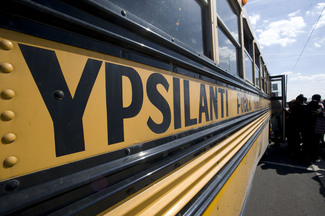
Both Ypsilanti and Willow Run districts contract with Washtenaw Intermediate School District for busing services.
Mark Bialek | For AnnArbor.com
That is the lowest the district's foundation allowance has been since 2003-04, when Willow Run was given $7,200 per child. Its funding high was in 2008-09 at $7,840 per child, according to the Senate Fiscal Agency.
To cut costs, Willow Run has privatized its food service management, as well as its business manager, school officials said. It also contracted with the Washtenaw Intermediate School District for busing as part of the transportation consortium with Ypsilanti and Ann Arbor Public Schools.
Additionally, Ypsilanti and Willow Run share a special education director, a Junior Reserve Officers' Training Corps (JROTC) program and vocational training course offerings through the Regional Career Technical Center (RCTC). Lincoln Consolidated School District also is a part of the RCTC.
Ypsilanti Public Schools began operating with a deficit in June 2009, school officials said.
They added Ypsilanti has cut about $5.5 million from its nearly $49.7 million operating budget since 2009. Ypsilanti’s accumulated deficit as of May is about $9.9 million.
Ypsilanti currently receives $7,513 per student, just $86 less than it received in 2005-06. Its high also was in 2008-09, when it had a foundation allowance of $7,983.
The ethnic breakdown of Ypsilanti and Willow Run’s student bodies are nearly identical. African Americans constitute about two-thirds of the population at both districts.
Caucasians are the second-highest ethnic group at about 28 percent. About 5 percent of students at both Ypsilanti and Willow Run are Hispanic or Latino.
Willow Run has 960 fewer students enrolled today than it had in 2005-06, according to data collected by the Center for Educational Performance and Information. Its headcount in fall 2005 was 2,632 students. In 2011, it tallied 1,672 students.
During the same timeframe, the total number of students enrolled at Ypsilanti decreased by 480. As of fall 2011, YPS had 3,654 students, down from 4,134 in 2005-06 and from 3,860 in 2009-10, data shows.
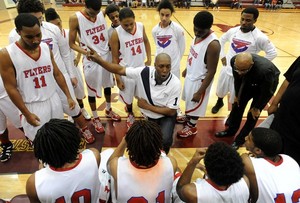
In the 2011-12 school year, Willow Run offered nine varsity sports and had 141 participants.
Angela J. Cesere | AnnArbor.com
Ypsilanti Public Schools offered 23 varsity sports and had 609 students participate in varsity athletics in 2011-12. By comparison, Willow Run offered nine varsity sports and had 141 participants.
Ypsilanti had an additional 189 students enroll in high school music programs in 2011-12. There were 79 high school choir students and 110 band students.
Willow Run had about 30 high schoolers in band this year and about an additional 100 students in choir programs.
Willow Run high schoolers are required to adhere to a dress code. They must wear navy, black or khaki colored pants, skirts or shorts and solid-colored shirts with collars. Denim is not permitted.
In measures of student achievement, both districts ranked far below state and countywide averages in 2011 for proficiency on standardized tests.
According to a report in Bridge Magazine last month, 3 percent and 4 percent of Willow Run and Ypsilanti students, respectively, were considered “college ready” based on their scores on the ACT exam. The statewide college readiness average was 17 percent.
Additionally, 39 percent of Michigan students had proficient scores on the Michigan Merit Exam (MME) last year, while 13 percent and 17 percent of Willow Run and Ypsilanti students, respectively, met the standards, according to Bridge Magazine's database.
CEPI data shows that in 2011, Willow Run’s graduation rate was 46.04 percent, with a dropout rate of 20.14 percent. Ypsilanti’s dropout rate was 15.43 percent, with a graduation rate of 57.45 percent. The statewide graduation and dropout averages were 74.33 percent and 11.13 percent, respectively.
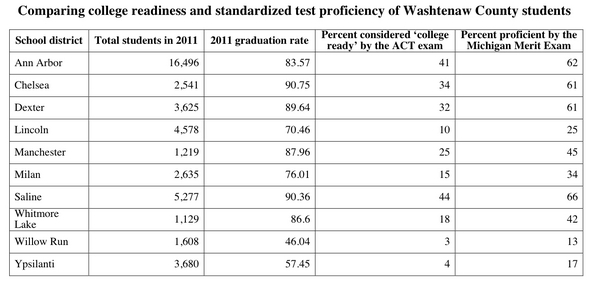
Source: Bridge Magazine and the Center for Educational Performance and Information
On the Michigan Educational Assessment Program exam, just 4.1 percent of Willow Run high schoolers were proficient in social studies in 2011, compared with 19.7 percent of freshmen in 2010. Also last year, 2 percent of Willow Run eighth-graders were proficient in science, while 8.2 percent of Ypsilanti’s students met the standards. The remaining Washtenaw County districts all were in double-digits in science.
Math and reading scores for Ypsilanti and Willow Run, as well as the other members of the WISD, can be found here.
During the past two years of budget cuts, Ypsilanti reduced its total teaching staff by 37 FTEs or full-time equivalents.
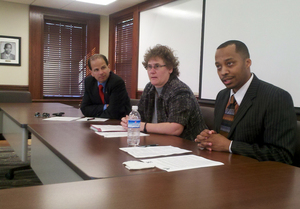
Willow Run Superintendent Laura Lisiscki, center, makes $20,000 less per year than Ypsilanti Superintendent Dedrick Martin, right.
Danielle Arndt I AnnArbor.com
Of the 37 fewer FTEs, 14 were classroom teachers.
YPS employs five fewer principals and central administrators today than it did two years ago, 20 compared with 25.
The average teacher at YPS makes $61,058. The average administrator salary is $94,594. Ypsilanti Superintendent Dedrick Martin is paid $140,000.
Ypsilanti has proposed 97 layoffs and position eliminations for 2012-13. Of those, 51 are para-professionals who already have received pink slips. The remaining 46 could be general or special education teachers. Final layoff numbers will be discussed at today's Board of Education meeting.
The number of Willow Run teachers, counselors and social workers has remained virtually the same in the past two years, from 115 in 2009-10 to 113 this year. During a news conference in March to talk about the potential merger with Ypsilanti, Superintendent Laura Lisiscki said Willow Run already has a bare-bones classroom staff.
The district has decreased its administrative staff, including both principals and central administrators, from 11 to nine since 2009-10.
The average teacher makes $56,361 at Willow Run Community Schools, whereas the average administrator makes $67,148. Lisiscki's salary is $120,000.
Ypsilanti Public Schools has twice as many K-12 buildings in operation as Willow Run. It also has 54 percent more students.
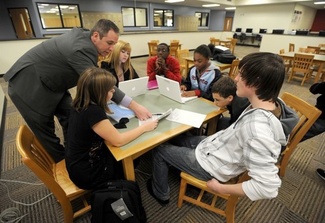
Students interact at Ypsilanti's New Tech High School.
Angela Cesere | AnnArbor.com
The district owns 1.064 million square feet of property, including the above eight buildings, an administrative building, bus garage, concession stand and a maintenance building. YPS also has three former schools that were closed and now are used to house countywide programs.
Ypsilanti, unlike Willow Run, does not have any K-12 buildings not in use. It does, however, have three properties it may be interested in selling: the bus garage, a property on River Street and one on LeForge Road.
Willow Run has three former schools sitting empty: Thurston Early Childhood Development Center, Kettering Elementary and Kaiser Elementary. These schools were closed around 2009.
Willow Run reconfigured its district to use just four buildings: the Primary Learning Center for children in pre-school through first grade, the Elementary Learning Center for second through fourth grade, the Intermediate Learning Center for fifth through eighth grade and the high school. The district owns 620,309 square feet of property.
Staff reporter Danielle Arndt covers K-12 education for AnnArbor.com. Follow her on Twitter @DanielleArndt or email her at daniellearndt@annarbor.com.


Comments
sc8
Tue, Jun 12, 2012 : 12:26 a.m.
Bragg was simply stating the truth. The performance data doesn't lie. 4% of Ypsilanti graduates and 3% of Willow Run graduates are prepared for college according to the table included in this article.
Macabre Sunset
Mon, Jun 11, 2012 : 8:54 p.m.
Bragg, more than 5,000 students are brought to the table here. The schools are struggling, but they are only as strong as the parents of those students. The only way to turn this around is to get parents more involved and more invested in the idea that their children are worth educating. Ripping the school districts (even with Willow Run's well-documented leadership problems) isn't relevant to the issue.
Macabre Sunset
Tue, Jun 12, 2012 : 5:11 p.m.
Mandatory parenting classes. Expulsions for bad behavior. More use of last-resort schools. More use of trade schools.
greg, too
Tue, Jun 12, 2012 : 4:32 a.m.
So, how do you propose to do this? Everyone knows this is the problem, so outside of throwing out common knowledge, what is your novel solution to this problem? As a career educator, I am interested in how you believe you can solve this.
braggslaw
Mon, Jun 11, 2012 : 4:48 p.m.
Not much is brought to the table by either district.
greg, too
Tue, Jun 12, 2012 : 4:30 a.m.
It's a pretty honest opinion. They both bring debt and failing schools and well paid administrators.
Peter
Mon, Jun 11, 2012 : 3:54 p.m.
Yeah. Claiming that the average teacher in the Willow Run district makes 56k is absolutely ludicrous.
Ryan
Mon, Jun 11, 2012 : 1:48 p.m.
I'm very interested in the reported average salaries for teachers in Ypsi. The article states that the teachers average $61,000/year, which sounds absolutely crazy to me as my mother taught for YPS for 30 years and retired making just at $60,000 her last year or two and she has her Masters degree. I speak to a lot of teachers on a daily basis and many of the teachers I know today make between $40-50,000k/year, if they are lucky. I guess my question is this: who are the teachers who make so much more than the rest that they can bring the average salary up so much? Most classroom teachers in Ypsi make significantly less than $60K/year, so what is going on here? Also, the reported income for YPS Superintendent is a little misleading. His pay on paper is $140,000 this year (down from $170,000 previously), but he brought home $153,000 on his W-2 and if you figure in his retirement and health care he makes a total of $222,164. It looks like he has a pretty good insurance and retirement package: http://www.ypsd.org/downloads/financial/earning_greater_than_100k1_20120522_153524_9.pdf That is a lot of money to manage a bottom rung school district like YPS. Our teachers are our front line workers and they make less than half what the Superintendent makes and he doesn't educate kids, which is the whole point of schools. We are saddled with crushing retirement obligations for public school administrators and it is killing us as taxpayers. We have to stop paying administrators grossly outsized salaries for their limited contributions to our childrens education and not just in Ypsilanti. Managing buildings and payrolls is important but teaching our children effectively is more important. My 2 cents.
greg, too
Tue, Jun 12, 2012 : 4:29 a.m.
I guess when you are swinging for a miracle worker, sometimes you just get someone who will ride out the high salary as long as possible. I agree, he is paid far too much when you add in all of his benefits...which is even worse when he is getting paid such a bloated salary and then laying off the teachers who actually teach the students.